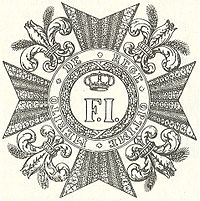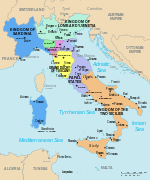History
The Royal Order of Francis I was founded on 28 September 1829 as an award of civil merit in the Kingdom of the Two Sicilies for distinction in public service, science, the arts, agriculture, industry and commerce.
Although the order was a State Order and the Kingdom of the Two Sicilies ceased to exist in 1860, the Order continued to be awarded by the exiled King Francis II and his brother and successor Prince Alfonso, Count of Caserta, although the latter did so for the last time in 1920, since they were still claiming all the prerogatives of the crown. His successor as head of the Dynasty, Prince Ferdinand Pius, Duke of Calabria who was head of the family from 1934-1960 accepted the de facto existence of the Italian State and abandoned an active pretension to the throne, considering the order to be abeyance. The latter's nephew, Infante Alfonso, Duke of Calabria, and great-nephew Infante Carlos, Duke of Calabria continued this policy, as has the latter's son and heir.
Prince Carlo, Duke of Castro, much like his father, Prince Ferdinand, Duke of Castro, head of the line of the family descended from Prince Ranieri, Duke of Castro has claimed the title and right of Grand Master and bestowed the order.

Francis I of the Two Sicilies was King of the Two Sicilies from 1825 to 1830 and regent of the Kingdom of Sicily from 1806 to 1814.

The Illustrious Royal Order of Saint Januarius is a Roman Catholic order of knighthood founded by Charles VII of Naples in 1738. It was the last great dynastic order to be constituted as a chivalric fraternity, with a limitation to Roman Catholics and a direct attachment to the dynasty rather than the state. The founder of the order, Charles VII of Naples, ruled from 1734 until 1759.

The Order of Saints Maurice and Lazarus is a Roman Catholic dynastic order of knighthood bestowed by the royal House of Savoy. It is the second-oldest order of knighthood in the world, tracing its lineage to AD 1098, and it is one of the rare orders of knighthood recognized by papal bull, in this case by Pope Gregory XIII. In that bull, Pope Gregory XIII bestowed upon Emmanuel Philibert, Duke of Savoy and his Savoy successors, the right to confer this knighthood in perpetuity. The Grand Master is Prince Emanuele Filiberto of Savoy, Prince of Venice, also known as the Duke of Savoy, the grandson of the last King of Italy, Umberto II. However, Emanuele Filiberto's cousin twice removed Prince Aimone, Duke of Aosta claims to be grand master as his father claimed to be head of the house of Savoy.

Prince Ludwig Ferdinand Maria Karl Heinrich Adalbert Franz Philipp Andreas Konstantin of Bavaria was a member of the Bavarian House of Wittelsbach and a General of Cavalry. Following his marriage to Infanta María de la Paz of Spain, he was also created an Infante of Spain.

Don Carlos María Alfonso Marcelo de Borbón-Dos Sicilias y Borbón-Parma, Infante of Spain, Duke of Calabria was, at his death, the last male infante of Spain during the reigns of his cousins King Juan Carlos I and King Felipe VI.

Duke of Calabria was the traditional title of the heir apparent of the Kingdom of Naples after the accession of Robert of Naples. It was also adopted by the heads of certain Houses that had once claimed the Kingdom of Naples in lieu of the royal title.

Prince Ferdinand Pius, Duke of Calabria and Castro, was head of the House of Bourbon-Two Sicilies and pretender to the throne of the extinct Kingdom of the Two Sicilies from 1934 to 1960.

Prince Alfonso, Count of Caserta was the third son of Ferdinand II of the Two Sicilies and Archduchess Maria Theresa of Austria.

The House of Bourbon-Two Sicilies is a cadet branch of the House of Bourbon that ruled Southern Italy and Sicily for more than a century in the 18th and 19th centuries. It descends from the Capetian dynasty in legitimate male line through Philip, Duke of Anjou, a younger grandson of Louis XIV of France (1638–1715) who established the Bourbon dynasty in Spain in 1700 as Philip V (1683–1746). In 1759, King Philip's younger grandson was appanaged with the kingdoms of Naples and Sicily, becoming Ferdinand IV and III (1751–1825), respectively, of those realms. His descendants occupied the joint throne, merged as the "Kingdom of the Two Sicilies" in 1816, until 1861, claimed it thereafter from exile, and constitute the extant Bourbon-Two Sicilies family.

Prince Ranieri Maria Gaetano, Duke of Castro was a claimant to the headship of the House of Bourbon-Two Sicilies.
Prince Ferdinand of Bourbon-Two Sicilies, Duke of Castro was a claimant to the headship of the former Royal House of the Two Sicilies.
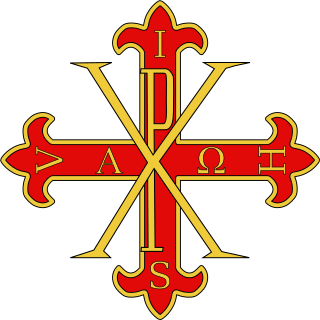
The Sacred Military Constantinian Order of Saint George, also historically referred to as the Imperial Constantinian Order of Saint George and the Order of the Constantinian Angelic Knights of Saint George, is a dynastic order of knighthood of the House of Bourbon-Two Sicilies. Currently, the grand magistry of the order is disputed among the two claimants to the headship of the formerly reigning House of Bourbon-Two Sicilies as heirs of the House of Farnese, namely Prince Pedro and Prince Carlo. The order was one of the rare orders confirmed as a religious-military order in the papal bull Militantis Ecclesiae in 1718, owing to a notable success in liberating Christians in the Peloponnese. Together with the Sovereign Military Order of Malta, it is one of a small number of Catholic orders that still have this status today. It is not an order of chivalry under the patronage of the Holy See, but its membership is restricted to practising Catholics.

Prince Carlo of Bourbon-Two Sicilies, Duke of Castro is one of the two claimants to the headship of the former House of Bourbon-Two Sicilies.
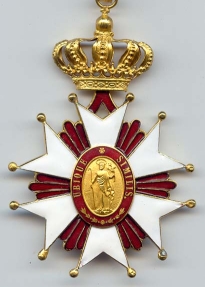
The Order of Saint Joseph was instituted on 9 March 1807 by Ferdinand III, Grand Duke of Tuscany during his reign as Grand Duke of Würzburg. It was transformed into a Tuscan Roman Catholic Dynastic Order in 1817.

The Order of Saint George of the Reunion is an order of knighthood of the Kingdom of the Two Sicilies. It was established to replace the Royal Order of the Two-Sicilies.
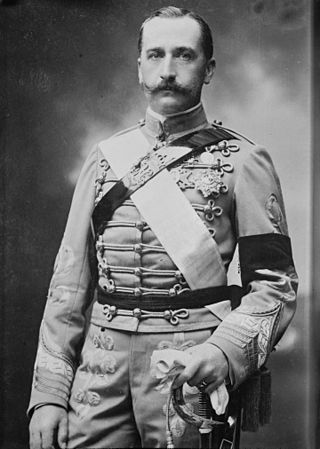
Don Carlos, Prince of Bourbon-Two Sicilies, Infante of Spain was the son of Prince Alfonso of the Two Sicilies, Count of Caserta and his wife Princess Maria Antonietta of Bourbon-Two Sicilies, and nephew of the last King of the Two Sicilies, Francis II.
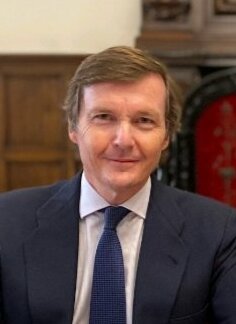
Prince Pedro of Bourbon-Two Sicilies, Duke of Calabria, Grandee of Spain, is the only son of Infante Carlos, Duke of Calabria (1938–2015), and his wife, Princess Anne of Orléans. As primogeniture heir of the kings of the Two Sicilies he is the principal claimant to the headship of the Royal House of Bourbon-Two Sicilies, which ruled the Kingdom of the Two Sicilies before the unification of Italy.

The House Order of Albert the Bear was founded in 1836 as a joint House Order by three dukes of Anhalt from separate branches of the family: Henry, Duke of Anhalt-Köthen, Leopold IV, Duke of Anhalt-Dessau, and Alexander Karl, Duke of Anhalt-Bernburg.

The Order of the Griffon was a State Order of the Grand Duchy of Mecklenburg-Schwerin. Established on 15 September 1884, it was created to honour benevolence and outstanding service to the public. In August 1904, the Order of the Griffon was extended to citizens of the Grand Duchy of Mecklenburg-Strelitz, with the rulers of the two grand duchies serving jointly as the Grand Masters of the order.
The Order of Civil Merit was an Order of Merit of the Kingdom of Bulgaria. Established in 1891, it had six classes.
